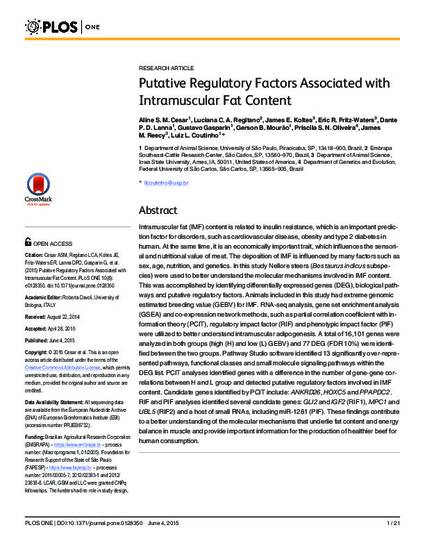
Intramuscular fat (IMF) content is related to insulin resistance, which is an important prediction factor for disorders, such as cardiovascular disease, obesity and type 2 diabetes in human. At the same time, it is an economically important trait, which influences the sensorial and nutritional value of meat. The deposition of IMF is influenced by many factors such as sex, age, nutrition, and genetics. In this study Nellore steers (Bos taurus indicus subspecies) were used to better understand the molecular mechanisms involved in IMF content. This was accomplished by identifying differentially expressed genes (DEG), biological pathways and putative regulatory factors. Animals included in this study had extreme genomic estimated breeding value (GEBV) for IMF. RNA-seq analysis, gene set enrichment analysis (GSEA) and co-expression network methods, such as partial correlation coefficient with information theory (PCIT), regulatory impact factor (RIF) and phenotypic impact factor (PIF) were utilized to better understand intramuscular adipogenesis. A total of 16,101 genes were analyzed in both groups (high (H) and low (L) GEBV) and 77 DEG (FDR 10%) were identified between the two groups. Pathway Studio software identified 13 significantly over-represented pathways, functional classes and small molecule signaling pathways within the DEG list. PCIT analyses identified genes with a difference in the number of gene-gene correlations between H and L group and detected putative regulatory factors involved in IMF content. Candidate genes identified by PCIT include: ANKRD26, HOXC5 and PPAPDC2. RIF and PIF analyses identified several candidate genes: GLI2 and IGF2 (RIF1), MPC1 and UBL5 (RIF2) and a host of small RNAs, including miR-1281 (PIF). These findings contribute to a better understanding of the molecular mechanisms that underlie fat content and energy balance in muscle and provide important information for the production of healthier beef for human consumption.
Available at: http://works.bepress.com/james_reecy/85/

This article is from PLoS One 10 (2015): e0128350, doi:10.1371/journal.pone.0128350. Posted with permission.